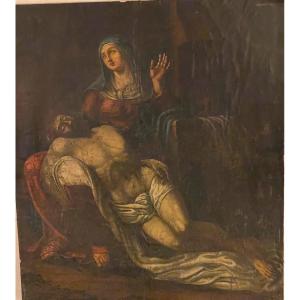Attributable to Pomponio Allegri (Correggio, 1522 - Parma, 1593)
Madonna and Child, Two Angels and John the Baptist
Oil on wooden panel, cm. 92 x 69, with frame cm. 119 x 96
LINK: https://www.antichitacastelbarco.it/it/prodotto/madonna-col-bambino--due-angeli-e-san-giovanni-allegri
The work, whose format leads us to hypothesize it was intended for domestic devotion, illustrates a pleasant testimony of Emilian art of the full sixteenth century, with evident references to the school of Antonio Allegri, known as Correggio (Correggio c. 1489 - therein 1534 ), the undisputed master for the great elegance of his creations, perfectly calibrated between chromatic finesse and dynamic effect, obtained thanks to the concatenation of gestures and glances.
Taking Leonardo da Vinci's lesson to its extreme, he managed to grasp the most authentic link between the various figures, and moreover, by virtue of the expressive sweetness of his characters and the wide use of perspective, he established himself in the Po Valley as the most modern and daring bearer of the ideals of the Renaissance.
As we can also see in our beautiful table, he contrasted the explosion of Venetian color and Roman mannerism with a fluid, luminous style of strong emotional involvement.
Deepening the stylistic analysis, it is easy to place the authorship in the hands of Pomponio Allegri; the setting of the figure of the Virgin in particular, with the head slightly bent, the lowered gaze and the pose of her body recall, almost by copying it, the Madonna del Latte of Budapest made by her father.
The composition, extremely refined, sees the Madonna sitting with the Child supported on her knees, and is enriched by the presence of a couple of angels, one holding a branch full of cherries in his hands and the other offering a part of it. to the child, fruits alluding to the original Sin, by virtue of the red color of the blood of the Passion. Behind, finally, on the right, is a young St. John the Baptist, already with his typical attributes of a hermit in the desert, namely the camel fur and the rod with the cross.
Detail of pure poetry is then the glimpse that we can glimpse on the right, treated with a vigor and a spirit of modernity rare for the time, characterized by a bright color and a clear light, revealing a village and a suggestive castle perched.
Pomponio's production is very detailed, since in his works we can see amalgamated both the formal researches and the linearisms of the last Parma Mannerists and, above all, the distinctly classical stylistic features close to the art of his father, Antonio Allegri known as Correggio (Correggio c. 1489 - therein 1534).
He was trained in the paternal workshop and was a pupil of it, albeit for a very short time, they manifest the clear adherence to the taste and style of the master and the fidelity to his compositional and typological modules, which testify to the dependence of the art of Pomponius from that of the Correggio.
Pomponio's first works date back to around the middle of the century and the frescoes for the Corpus Domini chapel in the church of San Quirino in Correggio date back to 1546. In 1555 we know it then in Reggio Emilia where he will stay until the definitive move to Parma in 1559, enjoying some success on the part of the local client.
In the panel, which we can place at the full maturity of the painter, we note that the typology of the Virgin responds to a peculiar model of his production, characterized by a massive corporeality and, as we have already anticipated, an iconographic conception typical of Correggio.
The depiction scheme proposed in the painting also refers to the graceful paternal compositions: the characters, characterized by rigid and restrained gestures, arrange themselves in a diagonal pattern interrupted by the figure of Mary, steadfast and immobile in her still rather centralized position.
For more information, please contact us.
The work, like all our objects, is sold with a certificate of photographic authenticity in accordance with the law.
Follow us also on:
https://www.instagram.com/galleriacastelbarco/?hl=it
https://www.facebook.com/galleriacastelbarco/


















































 Le Magazine de PROANTIC
Le Magazine de PROANTIC TRÉSORS Magazine
TRÉSORS Magazine Rivista Artiquariato
Rivista Artiquariato